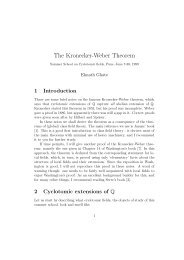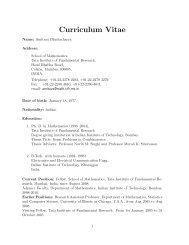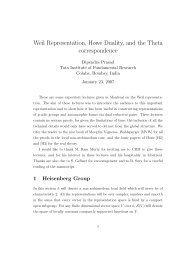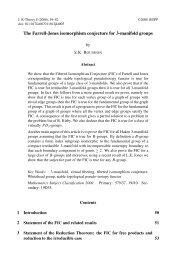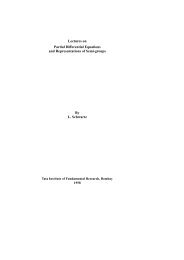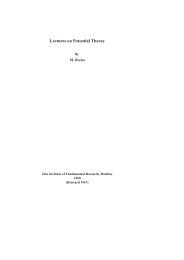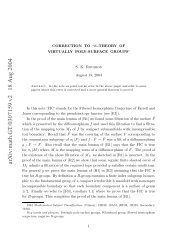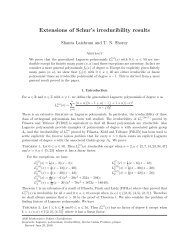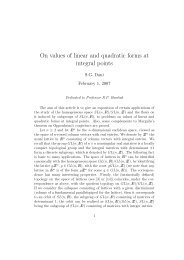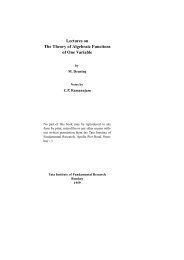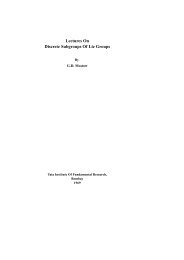Divisibility properties of generalized Laguerre polynomials
Divisibility properties of generalized Laguerre polynomials
Divisibility properties of generalized Laguerre polynomials
Create successful ePaper yourself
Turn your PDF publications into a flip-book with our unique Google optimized e-Paper software.
for ex E lIt n EN. An important instance is given by the case ex = -2n -there we have the relationI, sinceand B II (x) are the Bessel <strong>polynomials</strong>. The leading coefficient is given by (-I )11 [n',In this paper we are concerned with questions on the divisors <strong>of</strong> L~C/)(x) over Q.In 1929, Schur proved that L[,O)(x) and L;,-n-I)(x) are irreducible (over Q) andin 1931 he proved the same for L~l \x) (cf. [14,15]). A new pro<strong>of</strong> for the caseex = -n - 1 was given by Coleman [I] in 1987 by using the Newton polygon. In fact,Coleman and Filaseta developed a new method for attacking these kind <strong>of</strong>problems.An overview <strong>of</strong> the results can be found in [4]. Filaseta [3] proved in 1995 thatL~-211-1)(x)is irreducible for all but finitely many n, and in turn he immediatelyobtained the same result for the Bessel <strong>polynomials</strong> (by the connection givenabove). Later in 2002, Filaseta and Trifonov [6] extended this result to all integers n.In the same year, Filaseta and Lam [5] proved that L[,lY) (x) is irreducible for all butfinitely n for a fixed ex E Q\Z-. We point out that the exclusion <strong>of</strong> the negativeintegers is really necessary, since for ex = -r with r E N an easy computation showsthat L~C/) (x) is reducible for n ~ r. The irreducibility for ex = -n - rand r = 2, ... , 9was shown by Hajir [9,10] (the case r = 3 is by Sell [16]). Hajir also proved that fora fixed positive integer r the polynomial L~-II-r)(x) is irreducible for all but finitelymany n. We mention that the statements on all but finitely many n are effective inthe sense that an explicit lower bound for the n from which onward the statementis true can be given. Hajir conjectured in [10] that for all non-negative integers n, 5the <strong>generalized</strong> <strong>Laguerre</strong> polynomial L;,-II-S-1)(x) is irreducible. Another instance<strong>of</strong>this problem was recently considered by Filseta, Kidd and Trifonov in [7]. Theyshowed that L~I1) (x) is irreducible for every n with n == 2 (mod 4) with the exceptionn = 2, where this is false, and for all other n the polynomial L;:') (x) is eitherirreducible or it is a linear polynomial times an irreducible polynomial <strong>of</strong> degreen-I.Instead <strong>of</strong>proving that L~-II-s-I)(x) is irreducible one can try to exclude divisors<strong>of</strong> large degree for many values <strong>of</strong> 5. Recently, Tijdeman and the second author[13] proved that for every 0:::;ex :::; 30, ex E Z and 4 < k :::; g, the polynomial L~C/) (x)has no factor <strong>of</strong> degree k, Moreover, they proved that if 2 :::; k :::; g and 5 is aninteger with 0:::; 5:::; 0.95k, then L~-II-S-1)(x) does not have a factor <strong>of</strong> degree k.In their paper they study in fact a more general situation than the case <strong>of</strong> <strong>Laguerre</strong><strong>polynomials</strong>, where the above results are just some special cases. In this paper weshall consider an analogous problem for L~'I1+s') where 5' and It'l ~ I are integers.Now we fix some notation which we shall always follow in this paper withoutreference. Let n, 5, t be integers with n ~ 2,0:::; 5:::;n and let ex be given by either(I) ex =-tn - 5 - I with t ~ 2or(2) ex = tn + 5 with t ~ I.218
First let (j satisfy (1), We haveL(.()(x) =/I," tn - tn - s - 1)··· (j + 1 - tn - s - I) ,L(n _ j)!j!)=0 'L " (-(t-l)n-s-I)···(j-tn-s) ,= (-x»), (n - j)!j!(-x).Jand thereforewhere1=0"L" «t-l)n+s+I)···((t-I)n+s+j) ,,-)'- (-I) x( n - J ")1.J.'fj=O"(-I)"nlL;,"\x) =: LC)X"-).) =0(3) c) = (~ ) ((t - I)n + s + 1) ... ((t -- l)n + s + j)(t - l)n + s + j ) ( . I)= ( . 11-./+ .. ·n ../Observe that for every m E {O•...• n} we thus have(4)('/1 tt n + s)! (n - m)!-----. -ms,(tn+s-nz)! n!Let ex satisfy (2). Thenwhere~(t+l)n+s)(-x») ~, -(-I)"n!L~")(x)=(-I)"n!~ . n-' _._!_=:~c)xl1-.J.)=0 J J j=()(5) c', = (-1)j (~ ) ((t + 1)11 + s - j + 1) ... ((t + l)n + s).Thus(6)C;l 1Il (tn + s + m)! (11 - m)l-,-=(-1) .' ·m!c"_111 (til + s)! 11!for every m E {O. I..... 11}. The relations (4) and (6) will be <strong>of</strong> importance later on.For 0 ~ j ~ n, we write eI) =
andnF(x):= 'Lajdjx"-Jj=Ofor integers aD, at, ... , all' In the sequel we will denote by 111,112, ... effectivelycomputable absolute positive real constants. We have the following result.Theorem 1. Let e = 1/5 if a < 0 and e = 1/112 if a > O. Let aD, al, ... , an be anyintegers with laoI= IallI= 1. Then there exists a constant 11 I such thatfor all k withn111 < k
the polynomial F (x ) does not have a factor <strong>of</strong>degree k.The pro<strong>of</strong>s <strong>of</strong> Theorems I and 3 split in two parts. First by using p-adicarguments, especially the p-adic Newton polygon, we reduce the problem to findinga prime p having certain <strong>properties</strong>. By considering several cases depending on kthe pro<strong>of</strong>will be finished.In the next section we introduce the Newton polygon with respect to a prime pand give some auxiliary results on this polygon, as well as on primes in certainintervals. Afterwards, we will give the pro<strong>of</strong>s <strong>of</strong> Theorem I and 3, respectively.2. NEWTON POLYGONS AND PRELIMINARIES ON PRIMESFor a prime p let vp be a p-adic valuation, i.e. for a positive integer n we have thatvl'(n) is the largest integer such that pvp(n) In (we will also use the notation pVp(lI) lin,for short) and vp(O) = 00. We shall also write v for "» when it will be clear fromthe context which p we are taking. Let g(x) = LJ-=o b[x":j E Z[x] with bobll :j:. O.The p-adic Newton polygon (or just Newton polygon) for g(x) with respect to theprime p is now defined as the polygonal path formed by the lower edges <strong>of</strong> theconvex hull <strong>of</strong>the pointsThe left-most endpoint is (0, v(bo)) and the right-most endpoint is (n, v(bll)).Moreover, the endpoints <strong>of</strong> each edge belong to the above set and the slopes <strong>of</strong>the edges strictly increase from left to right.Then Filaseta [3, Lemma 2] proved the following result.Lemma 1. Let k and i be integers with k > e;:: 0 and k ~ n12. Suppose thatIlg(x) = Lbjx"- j E Z[x]j-=Oand p is a prime such that p t bo, p Ibj for all j E Ii + I, ... , n} and the right-mostedge <strong>of</strong>the Newton polygon for g(x) with respect to p has slope < 11k. Thenforany integers ao, aI, ... , all with laoI= IallI=I, the polynomial11G(x) = Lajbjx ll - jj-=Ocannot have a factor with degree in the interval [i + 1,k].We apply this lemma in the case L~a)(x), in fact we will use g(x) = lex) andG(x) = F(x).The next result is an estimate on the difference between consecutive primes andit will be used in the pro<strong>of</strong> <strong>of</strong> Theorem I.221
Lemma 2 (Lou and Yao [12]), Denote 17.\' PII the n-th prime number and let F > O.There exists a constant 1)4 such that
espect to p has endpoints (.e - I, 0), (n, I) and therefore, by (7), its slope is 1/ (n €+ I) < 2/n :( I/k. By Lemma I we get a contradiction unless k:(.e. Hence wecan assume k:( e:( (tn)23/42.Now we consider two different cases depending on the size <strong>of</strong> k, namelyn 11/21 :( k and k < n I 1/21 :Assume that nll/21 :( k. Then since k ~(tn) 23 / 42 and 1/2 < 11/21, we haven 1t 2 < nll/21 ~ k ~ (tn) 23/ 42. We start by proving the following lemma whichextends Filaseta [3, Lemma 4] with t = 2, s = O.Lemma 4.p ): tk + 05Let n, rand k ~ n/2 be positive integers, eE {O, I, ... , k - I} and let+ I be a prime number satisfying p' lin - eand(8)log(tn+s) I 1----'-----+--~-.p" logp p - I kThen F(x) does not have a factor "...ith degree E [.e + I, kJ,Pro<strong>of</strong>. We start by introducing the functiona(n, j):= l;l j J-l n ;jmJ(obviously ain, j) also depends on m and p), which is equal to the number <strong>of</strong>multiples <strong>of</strong> pj in (n - m, nl and where LxJ is defined to be the largest integer:( x. Sincewe show that it suffices to prove that(9)for allma(tn+s,j)-a(n,j)~----:p'. llog(tn + s) J} ~ J:= .logpBecause <strong>of</strong>(4) we now haveV(Cn ) - v(cn - m ) v(m!) I [( (tn +o5)!) ( n! )]------=--+- v -vm m m (tn+s-m)! (n-m)!= v(m!) +'f-a(tn+s,j)-a(n,j),mj=1where the sum in fact just runs over j :( J, since for j > J we have pj > tn + s,which implies a(tn + s, j) = a(n, j) = O. Thus, by using the inequalities obtainedIn223
so far together with the hypothesis in (8), the slope <strong>of</strong> the right-most edge <strong>of</strong> theNewton polygon for f(x) is bounded byV(Cn) - v(cn- m ) } I log(tn+s) 1l~m~n{m p - I pt usg p kmax k ~ j it follows that plcj for j E {l + 1, ... , n}and p t Co = I (cf. equation (3)). Therefore, we get by Lemma 1 that F (x) does nothave a factor with degree E [e+ I, k]. This proves the assertion.We have to prove (9) and we do it by considering three cases depending on thesize <strong>of</strong> j and m,Case 1. Assume that 1 ~ j ( r: We will use that pr lin - e, which implies that thereis an integer u with n = prU + e. It follows thatltn + s J ltn+s-mJpjl= tpr-ju + --.- tl+SJ - ltp r-ju + tl+s-mJ .pJpJ= ltep:sJ_ltl+;j-mJ=-lte+;j-mJa(tn + s, j) = ---pr -nJ In-mJl l ' eJ l . l-mJpJ p) p) pJ= l:iJ-l e ~imJ=-l e ~imJa(n, j) = ----:- - --.- = pr- J u + ----:- _ pr-J u + --.-where we have used that our prime p satisfies pj ~ p > te + s. Therefore we geta(tn+s,j)-a(n,j)=-lt£+;j-mJ+le;i m J~O.It follows that (9) is trivially true.Case 2. Assume now m ~ te + s: It first follows that (tn + s - m, tn + s] ~ (tn +s - te - s, tn + s] = (tn - te, tn +s]. Since pin - e we get pltn - te. Together withp > te + s this implies that there is no multiple <strong>of</strong> pi in (tn + s - m, tn + s] at all,which gives attn + s, j) = O. Thus (9) again holds.Case 3. Finally assume j > r,m > fe+s: We observe that the number <strong>of</strong>multiples<strong>of</strong> pr in (tn +s - m, tn +s] ~ [tn - te, tn +s] is bounded by Lm/prJ + 1. Sincep ~ tk + s + 1 > t, the multiple tn - te <strong>of</strong> pr is not divisible by pi. Thereforea(tn+s,j)~a(tn+s,r)-l(l;JSo in this case the inequality (9) holds too.224
Altogether, we have covered all cases and this completes the pro<strong>of</strong> <strong>of</strong>Lemma 4. 0Thus we just have to prove that there is a prime p > 2eklogk, which impliesp > (t + l)k > (z + l)n 1/2 and p ~ tk + s + 1, that divides n(n - 1) ... (n - k + 1).Thenlog(tn+s) I 10g«t+l)n) I 1---'---- +--~. . + ~ -,prlog p p-l (t+l)klog«t+l)n l / 2 ) (t+1)k ksince log«t + I)n)jlog«t + l)n 1 / 2) ~ 2 ~ t and then the contradiction follows byLemma 4. To show that such a prime exists we use the following lemma, which isbased on an argument first given by Erdos in [2]. We take the following version thatcan be found in [7, Lemma 6].Let z be a positive real number. For each prime p ~ z. let d p E {n,nLemma 5.1, ... , n - k + I} with vp (dp) maximal. DefineQz = Qz(n, k) =npvr,(A)p>zwith A = n(n - 1)·· . (n - k + 1). Thenn(n - 1) ... (n - k + I)(n - k + V- 7T (z)Qz ~ (k _ 1)! f1 ' pvp(dp) ~ (k - I)! 'Pc...where ]fez) denotes the number <strong>of</strong>primes ~ z.We write z = Leklog k in this case. By the prime number theorem we haveWe get(I + 8)2ek log k]fez) ~ .log(2eklogk)1 )k-(IH)28klOgk/IOg(28klOgk)(10) Qz ~("2n (en logk)-23k/42~ (n 19/42-( I+8)2elogk/ log(2ek) (s log k) -23/422(1H)2elogkjlog(2ek)-1)k ,where we have used that n - k + I ~ ~n and (k - I)! ~ kk ~ (tn)23k/42 0, then the existence <strong>of</strong> aprime p with the required <strong>properties</strong> follows. The exponent <strong>of</strong> n is 19/42 - (I +o)2elogkflog(2£k) ~ 19/42 - 2£(1 +8)2 > 0, since logk/log(2ek) ~ 1+8, e = 1/5and 8 = 1/16, implying Qz > 1. This completes the pro<strong>of</strong> in the first case.225
Now we turn to the second case and assume that k < nil /21. In this case we canimmediately improve the lower bound for Q: in the arguments above to(11)I )k-(I+OI2FkIOgk/IOg(2tkl . i) . . . . 7~ -II Il-llk/_I>nk/41')-k>llk/4-Q zr ( 2 z-: ~ z-: ,since 10/21-(1 + 8)2elogk/log(2.sklogk) ~ 10/21-2£(1 +8)2 ~ 1/41. Now letp > z be a prime with pln(n - 1)··· (n - k + 1). Note that since p ~ tk + s + I > kit follows that p divides exactly one <strong>of</strong>n, /1 - 1, ... .n - k + I. Assume that pin - £with eE {O, ... , k - I} and let r > 0 be such that pI' lin - £. Moreover, observe that(with the notation <strong>of</strong> Lemma 5) we have r = vp(A). Since we are assuming thatF(x) has a factor <strong>of</strong>degree k it follows by Lemma 4 applied with this prime p thatwe must havelog(tn+s) 1 log(tn+s) 1 I--"--,--,.,--+--= +-->-.pVp(A)logp p-l pl'logp p-I kSince p > (t + l)k ~ 3k, we have I/(p-I) ~ 1/(3k) and therefore we deduce fromthe last formula thatv (A) 3klog«t + I)n) 3(1 +Iog(t+ I)/Iogn) Ip p < ~ klogn < -klogn;210gp 2Iog«t + I)k) 43this is true since (l29/2)(Iog(t + I) + logn) < logn log(t + 1) + logn Iogk. Therefore,we getand henceIlogk + loglogn -log43p < 43klogn and vp(A) < --=._--=-~----=,-logpII:Vp(A)logp< L (Iogk+loglogn-log43)~4/logn.P>Zz
Since p > In + s and therefore 2p > 21n + 2s ;;:: (t + l)n + S , we see that (t +I)n + s - t = p is the only multiple <strong>of</strong> p among the numbers (1 + l)n + S - jwith 0 ~ .i < n . Finally, from c;, = (_1)11ttn + S + I) ... «1 + l)n + s) we get thatvl'(c;,) = 1.Therefore, the right-most edge <strong>of</strong>the Newton polygon <strong>of</strong> f(x) has slope< 1/(n - k) ~ 1/k. This is not possible by Lemma I and therefore there is no factor<strong>of</strong> degree k in the range.Now we can assume that k < n 23 / 42 . We write z = 6Ek log k in this case. Byobserving that (1+ I)n + s - k + I ;;:: In + s ;;:: n, we get from Lemma 5Q~((t + I)n +s,k) ;;:: Ilk-][(~)1l-23/42k ;;:: (n 19/42- I,since 19/42 - 6e(l + 8)2> O. It follows that there is a prime p > Z ;;:: 2k dividing(1 + l)n + s - l with 0 ~ e ~ k - I. For such a prime it follows that pic) for.i E {e+ I, .... n} and we define In = In(p) E [l , ... , n} such thatVp(c~) - Vp(C~_II1)Inis the slope <strong>of</strong> the right-most edge <strong>of</strong> the Newton polygon for f(x) with respectto p. Then we have by Lemma 1 and (6) thatI vp(C;,) - VI'(C;HII)- ~ -=------'---k"'- In~ ~[v (Un .+. S +In)!) _ v((n))]In p (In+s)! p mI~ -vp ( ln + s + 1)"'(ln+s+m»)m~ ~ f(ltn +S+lnJ -ltn +SJ)In , pi pi/=1« ) I J I J I J,,;; - '" -;- + I ,,;;-- + - ,,;; - +-,m L.J pi P - I m 2k m/=1whereJ:= lI0 g «t+ I)n +S)J.logpIt follows that In ~ 2k J and thus(12)m ~2k log((t + I)n + s)log p4k log n< --- =:mo.logkSo this inequality is true for all primes p > z dividing (t + l)n + S -l with 0 ~ e~k -1.Let U := {(t+ l)n -l-s, .... U+ l)n +s - k + I}\{b q : q ~ z}, where for all primesq ~ z we have removed those numbers b q E {(t + l)n + s, ... , (1 + l)n + S - k + I}227
with v q (b q ) maximal. We mention, as we have already seen, that all elements <strong>of</strong> Uare? n. Now let Q be the set <strong>of</strong>all primes q > z with vq(u) > 0 from some U E Uand qVq(u) :::; 2e(m + k) logk for all U E U. Here we recall that m =m(q) satisfies(12), since q > z and divides some U E U. Observe that such a q divides exactly oneU E U, since q > z? k. Thus we haveIOg(n Il qVq(UJ) :::;IOg( ll 2e(mo+k)IOgk)UEU qEQ: 2e(m + k) logk. Let u = (t + l)n + s - ewith 0:::; e :::; k - I and let r be defined by qr > Zetm + k)logk ? «:' andsuch that qr divides u. Again, by (5), it follows that this prime divides cj forj E {e + I, ... ,n}. If q' divides tn + s + j for some 1 :::; j s; m, then it alsodivides (t + I)(tn + s + j) - t(U + l)n + s - e) = s + tj + t£ + j and thereforeqr :::; S + (t + l)m +t(k - 1) :::; Zetm+k) logk, which is a contradiction. Therefore,qr does not divide tn + s + j for all l s; j :::; m. Hence, we now have1 Vq(c~) - Vq(c~ m) I ( )- ~ - ~ -v q (tn +s + 1) .. · (tn +s +m)k m m1 r-l(m ) 1 r-I I r-l:::;-L: --:-+1 :::;--+-- z ? 3k. For r ? 2 we have2(2e(m + k) logk) ? 2qr- l > 2(6ek logkl- I? (6eklogkl- 1 +4eklogk228
and therefore4Enzlog k > (6ck log k)r-l ~ (r - I )6ek log k.Finally we concludeand3m>-k(r-I)2which is a contradiction. This completes the pro<strong>of</strong> <strong>of</strong>Theorem I.4. PROOF OF THEOREM 3We take e = 1/7 and 8 = 1/40 in the pro<strong>of</strong> <strong>of</strong> Theorem 3. Further, let 1'J3 besufficiently large. Assume that F(x) has a factor <strong>of</strong> degree k ~ tn such thatt < S logn, s < ek logn with 11 > 113.We can start as in the pro<strong>of</strong> <strong>of</strong> Theorem 1 and conclude that, actually, we mayassume that k ~ (tn)23/42. Moreover, we can follow the arguments given thereafterwards, but for k in the range k ~ (n/2)2/3. Namely, by applying Lemma 5 andthe prime number theorem we get that for z = Leklog n we haveI )k-rr(ZlQz ~ 2n (tn)-23k/42(? '3~ (nI9/42-(l+812c1ogn/l0g(2E(Il/21-1 log n)x (s logn)-23/42 2-1+(I+812E logn/ log(2E(Il/2 12/3!Og/l))k,which shows, since e = 1/7 and log n/ log(2s(n/2)2/3 log n) ~ 3/2, that there is aprime p > 2sk logn > sn 2 / 3 and p ~ tk +s + I that divides n(n -1) ... (n - k + I).For this prime we have tn + s < en logn + ek logn ~ Zenlogn andlog(tn + s) 1 log(2en logn) 1 1----+--~ . +---~-P log P P - I -c; Zeklogn log(en 2 / 3) sk: logn " kand therefore it follows by Lemma 4 that F(x) cannot have a factor <strong>of</strong>degree k.Let YJ6, 117 and YJ8 be the constants appearing in Lemma 3. We are left with k ~(n/2)2/3, i.e. with 2k 3/2 ~ n. Since we are assuming that logn ~ (logk)3/2(l+e1- 1 ~(logk)3/2(l-e/2) it follows thatand therefore that(log k)3/2log n ~ 1'J6 --,--~loglogk(13) k 3 / 2 < ':: < U '- n - k < n ~ k~6(logk)I/2/1og1ogk" 2"'- "" .229
Hence, by the same lemma we get that the largest prime factor p = p (u , k) <strong>of</strong>n(n -1),., (n - k + I) = (u + 1)(/1 + 2)··· (/I + k) satisfiesWe observe~ 2 ?IOgk ) - -2( loglogk ) (Ioglogn)-ACk, u) ~ ( logn ~ '76 (logk)1f 2 ~ 1}9 logkwhere we have used the last inequality in (13) again. Thus, p ~ IJlOk(1ogn)2 >k logn and p > Zek logn > tk + s. But sincelog(tn+s) I log(2snlogn) I I--"---- +-- s::: +-- s::: -p log p p - I '" k logn log(logn) p - I '" k:'it follows again by Lemma 4 that F(x) cannot have a factor <strong>of</strong> degree k. This is acontradiction.This completes the pro<strong>of</strong><strong>of</strong>Theorem 3.ACKNOWLEDGMENTSThis work was initiated when the second author was visiting ETH in April 2008and he would like to thank ETH for the invitation and hospitality. The authors aremost grateful to an anonymous referee for very careful reading <strong>of</strong>the paper and foruseful and important advice in preparing the revised version.REFERENCES[I] Coleman R.E - On the Galois groups <strong>of</strong> the exponential Taylor <strong>polynomials</strong>, L'EnseignementMath. 33 (1987) 183-189.[2] Erdos P.- On consecutive integers, Nieuw Archiefvoor Wiskunde (3) 3 (1955) 124-t28.[3] Filaseta M. - The irreducibility <strong>of</strong>all but finitely many Bessel <strong>polynomials</strong>, Acta Math. 174 (1995)383-397.[4] Filaseta M., Finch c.,Leidy 1.R.- TN. Shorey's influence in the theory <strong>of</strong>irreducible <strong>polynomials</strong>,in: Saradha N. (Ed.), Diophantine Equations, Narosa, 2008, pp. 77-t02.[5] Filaseta M., Lam T-Y. - On the irreducibility <strong>of</strong> the <strong>generalized</strong> <strong>Laguerre</strong> <strong>polynomials</strong>, ActaArith.l05(2002) 177-182.[6] Filaseta M., Trifonov O. - The irreducibility <strong>of</strong> the Bessel <strong>polynomials</strong>, 1.Reine Angew. Math. 550(2002) 125-140.[7] Filaseta M., Kidd T, Trifonov O. - <strong>Laguerre</strong> <strong>polynomials</strong> with Galois group Am for each m,Preprint, 2008.[8] Filaseta M., Williams R.L. Jr. - On the irreducibility <strong>of</strong> a certain class <strong>of</strong> <strong>Laguerre</strong> <strong>polynomials</strong>,1.Number Theory 100 (2003) 229-250.[9] Hajir F. - Some An-extensions obtained from <strong>generalized</strong> <strong>Laguerre</strong> <strong>polynomials</strong>, J. NumberTheory 50 (1995) 206-212.[10] Hajir F. - Algebraic <strong>properties</strong> <strong>of</strong> a family <strong>of</strong> <strong>generalized</strong> <strong>Laguerre</strong> <strong>polynomials</strong>, Canadian 1.Math.61 (2009) 583-603.[II] Jutila M. - On numbers with a large prime factor, II, 1. Indian Math. Soc. (N.S.) 38 (1974) (1975)125-130.[12] Lou S.T., Yao Q. - A Chebychev's type <strong>of</strong> prime number theorem in a short interval, II, HardyRamanujan 1. 15 (1992) 1-33.230
[13] Shorey T.N., Tijdeman R.- Generalizations <strong>of</strong> some irreducibility results by Schur, Acta Arith., toappear.[14] Schur I. - Einige Satze iiber Primzahlen mit Anwendungen auf Irreduzibilitatsfragen, I.,Sitzungsber. Preuss. Akad. Wiss. Berlin. Phys.-Math. KI. 14 (1929) 125-136.[15] Schur 1.- AffektIose Gleichungen in der Theorie der Lagurreschen und Hermiteschen Polynome,1. Reine Angew. Math. 165(1931) 52-58.[16] Sell E.A. _. On a certain family <strong>of</strong> <strong>generalized</strong> <strong>Laguerre</strong> <strong>polynomials</strong>, 1.Number Theory 107 (2004)266-281.(Received October 2008)231



